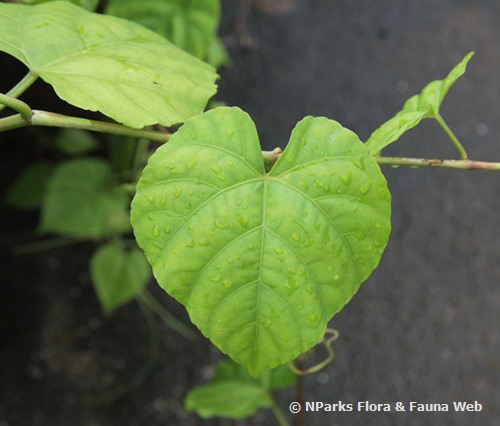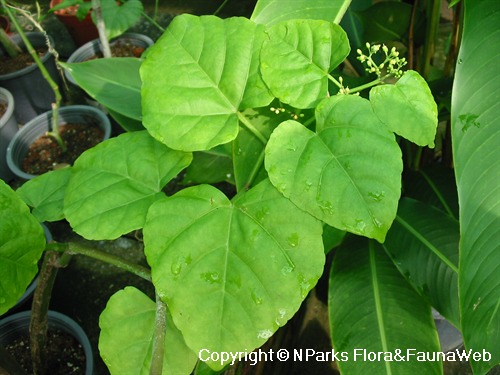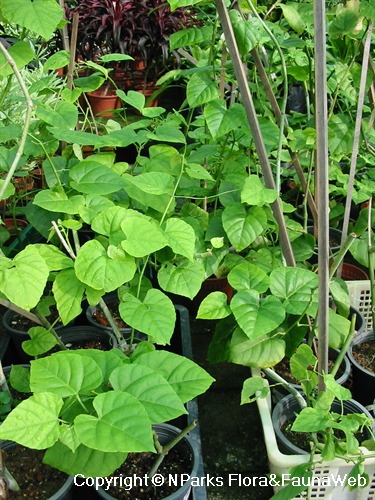
Back
Cissus repens Lam.
| Family Name: | Vitaceae |
| Synonyms: | Vitis repens W. & Arn. |
| Common Name: | Malayan Wild Vine, Carik Merah, Lakum, Pokok Riang Hutan, 白粉藤, 白薯藤 |
Name
Classifications and Characteristics
| Plant Division | Angiosperms (Flowering Seed Plants) (Dicotyledon) |
|---|---|
| Plant Growth Form | Climber |
| Lifespan (in Singapore) | Perennial |
| Mode of Nutrition | Autotrophic |
Biogeography
| Native Distribution | India, Myanmar, Cambodia, Vietnam, Thailand, through Malaysia, Singapore, the Philippines, Indonesia, and Brunei to Papua New Guinea and Australia. |
|---|---|
| Native Habitat | Terrestrial (Primary Rainforest, Secondary Rainforest, Coastal Forest, Freshwater Swamp Forest) |
| Preferred Climate Zone | Tropical, Sub-Tropical / Monsoonal |
| Local Conservation Status | Native to Singapore (Vulnerable (VU)) |
Description and Ethnobotany
| Growth Form | A woody climber. |
|---|---|
| Foliage | Its spirally arranged, stalked leaves have papery to leathery leaf blades that are simple, broad egg-shaped, cordate base, hairless, 3.5–8.5 by 2.5–8 cm, and with toothed margins. |
| Flowers | The flowers are borne on umbelliform inflorescences which are leaf opposed. Each flower is small insize and have four yellow petals, four stamens attached outside the disk and 1 stigma. |
| Fruit | Its fruits are round berries, up to 6 by 5 mm, and with 1 seed each. The seed is up to 4 mm across. |
| Habitat | It grows on the fringes of lowland dipterocarp and swamp forests. It occurs locally in Pulau Ubin. |
| Associated Fauna | Its flowers are pollinated by bees, and its fruits and seeds may be eaten and dispersed by birds. |
| Cultivation | It can be propagated by root cuttings, and sometimes roots spontaneously on intact stems pieces of which can then be removed for cultivation. |
| Etymology | Latin Cissus, ivy; Latin repens, unexpected or sudden, the reference to which is unknown |
| Ethnobotanical Uses | Edible Plant Parts : Edible Leaves Food (Fruit or Vegetable): The edible leaves are used in place of sorrel. Medicinal: The leaves can be used as a poultice for swelling and fever. Others: The leaves are used for stupefying fish. The stem is used as a cordage. |
Landscaping Features
| Landscaping | It is suitable for growing in parks on trellises and pergolas. |
|---|---|
| Desirable Plant Features | Ornamental Foliage |
| Landscape Uses | Parks & Gardens, Coastal, Trellis / Arbour / Pergola |
Fauna, Pollination and Dispersal
| Fauna Pollination Dispersal Associated Fauna | Bird-Attracting |
|---|---|
| Pollination Method(s) | Biotic (Fauna) |
| Seed or Spore Dispersal | Biotic (Fauna) |
Plant Care and Propagation
| Light Preference | Semi-Shade, Full Sun |
|---|---|
| Water Preference | Moderate Water |
| Plant Growth Rate | Fast |
| Rootzone Tolerance | Moist Soils, Well-Drained Soils, Fertile Loamy Soils, Easy to Grow |
| Propagation Method | Seed, Stem Cutting |
Foliar
| Foliage Retention | Evergreen |
|---|---|
| Mature Foliage Colour(s) | Green |
| Mature Foliage Texture(s) | Papery, Leathery |
| Foliar Type | Simple / Unifoliate |
| Foliar Arrangement Along Stem | Alternate, Spiral |
| Foliar Attachment to Stem | Petiolate |
| Foliar Shape(s) | Non-Palm Foliage |
| Foliar Venation | Pinnate / Net |
| Foliar Margin | Serrate / Toothed |
| Foliar Apex - Tip | Acute |
| Foliar Base | Cordate |
Floral (Angiosperm)
| Flower & Plant Sexuality | Bisexual Flowers |
| Flower Colour(s) | Green - Light Green, White, Yellow / Golden |
|---|---|
| Flower Grouping | Cluster / Inflorescence |
| Flower Location | Axillary |
| Flower Symmetry | Radial |
| Inflorescence Type | Corymb |
Fruit, Seed and Spore
| Mature Fruit Colour(s) | Purple |
|---|---|
| Fruit Classification | Simple Fruit |
| Fruit Type | Fleshy Fruit , Non-Accessory Fruit |
Image Repository
Others
| Master ID | 72 |
|---|---|
| Species ID | 1368 |
| Flora Disclaimer | The information in this website has been compiled from reliable sources, such as reference works on medicinal plants. It is not a substitute for medical advice or treatment and NParks does not purport to provide any medical advice. Readers should always consult his/her physician before using or consuming a plant for medicinal purposes. |







.jpg)